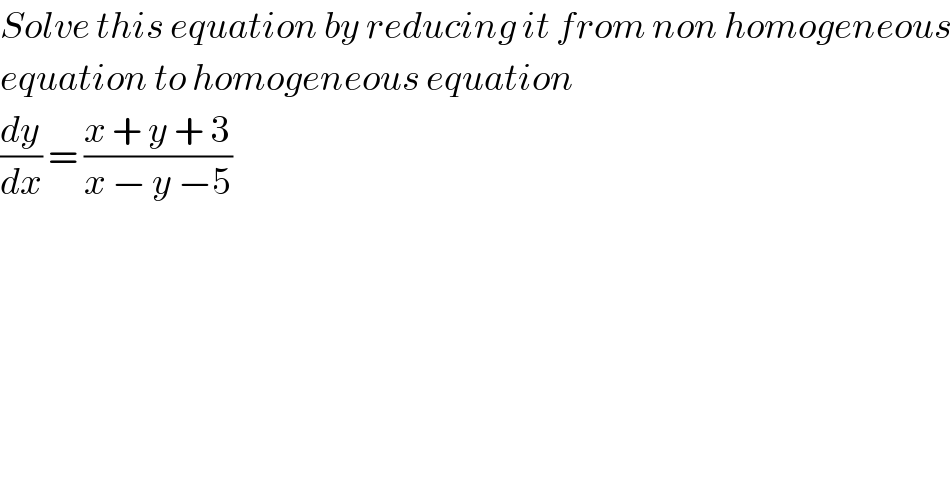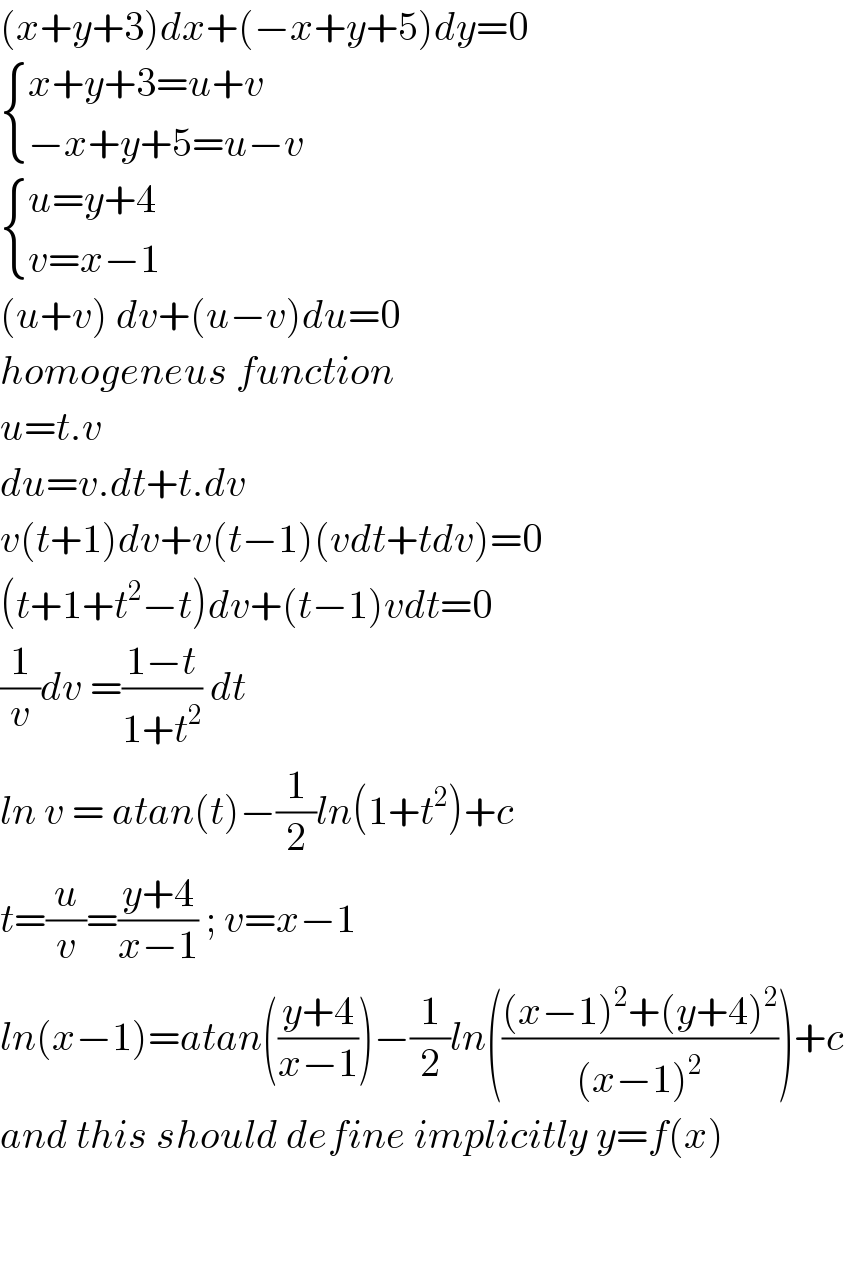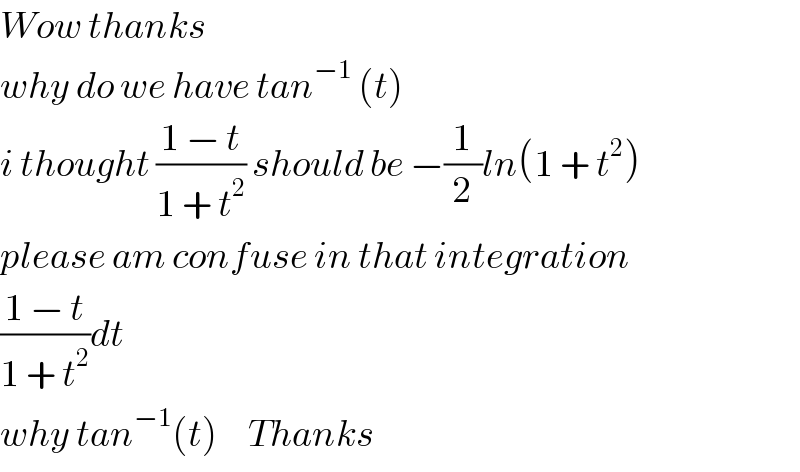
Previous in Differential Equation Next in Differential Equation
Question Number 6651 by Tawakalitu. last updated on 08/Jul/16

$${Solve}\:{this}\:{equation}\:{by}\:{reducing}\:{it}\:{from}\:{non}\:{homogeneous} \\ $$$${equation}\:{to}\:{homogeneous}\:{equation}\: \\ $$$$\frac{{dy}}{{dx}}\:=\:\frac{{x}\:+\:{y}\:+\:\mathrm{3}}{{x}\:−\:{y}\:−\mathrm{5}} \\ $$
Commented by prakash jain last updated on 09/Jul/16

$$\mathrm{Substitue}\:{x}={u}+\mathrm{1}\:\mathrm{and}\:{y}={v}−\mathrm{4} \\ $$$$\frac{{dv}}{{du}}=\frac{{u}+{v}}{{u}−{v}} \\ $$$$ \\ $$
Answered by nburiburu last updated on 09/Jul/16

$$\left({x}+{y}+\mathrm{3}\right){dx}+\left(−{x}+{y}+\mathrm{5}\right){dy}=\mathrm{0} \\ $$$$\begin{cases}{{x}+{y}+\mathrm{3}={u}+{v}}\\{−{x}+{y}+\mathrm{5}={u}−{v}}\end{cases} \\ $$$$\begin{cases}{{u}={y}+\mathrm{4}}\\{{v}={x}−\mathrm{1}}\end{cases} \\ $$$$\left({u}+{v}\right)\:{dv}+\left({u}−{v}\right){du}=\mathrm{0} \\ $$$${homogeneus}\:{function} \\ $$$${u}={t}.{v} \\ $$$${du}={v}.{dt}+{t}.{dv} \\ $$$${v}\left({t}+\mathrm{1}\right){dv}+{v}\left({t}−\mathrm{1}\right)\left({vdt}+{tdv}\right)=\mathrm{0} \\ $$$$\left({t}+\mathrm{1}+{t}^{\mathrm{2}} −{t}\right){dv}+\left({t}−\mathrm{1}\right){vdt}=\mathrm{0} \\ $$$$\frac{\mathrm{1}}{{v}}{dv}\:=\frac{\mathrm{1}−{t}}{\mathrm{1}+{t}^{\mathrm{2}} }\:{dt} \\ $$$${ln}\:{v}\:=\:{atan}\left({t}\right)−\frac{\mathrm{1}}{\mathrm{2}}{ln}\left(\mathrm{1}+{t}^{\mathrm{2}} \right)+{c} \\ $$$${t}=\frac{{u}}{{v}}=\frac{{y}+\mathrm{4}}{{x}−\mathrm{1}}\:;\:{v}={x}−\mathrm{1} \\ $$$${ln}\left({x}−\mathrm{1}\right)={atan}\left(\frac{{y}+\mathrm{4}}{{x}−\mathrm{1}}\right)−\frac{\mathrm{1}}{\mathrm{2}}{ln}\left(\frac{\left({x}−\mathrm{1}\right)^{\mathrm{2}} +\left({y}+\mathrm{4}\right)^{\mathrm{2}} }{\left({x}−\mathrm{1}\right)^{\mathrm{2}} }\right)+{c} \\ $$$${and}\:{this}\:{should}\:{define}\:{implicitly}\:{y}={f}\left({x}\right) \\ $$$$ \\ $$$$ \\ $$
Commented by Tawakalitu. last updated on 09/Jul/16

$${Wow}\:{thanks} \\ $$$${why}\:{do}\:{we}\:{have}\:{tan}^{−\mathrm{1}} \:\left({t}\right) \\ $$$${i}\:{thought}\:\frac{\mathrm{1}\:−\:{t}}{\mathrm{1}\:+\:{t}^{\mathrm{2}} }\:{should}\:{be}\:−\frac{\mathrm{1}}{\mathrm{2}}{ln}\left(\mathrm{1}\:+\:{t}^{\mathrm{2}} \right) \\ $$$${please}\:{am}\:{confuse}\:{in}\:{that}\:{integration} \\ $$$$\frac{\mathrm{1}\:−\:{t}}{\mathrm{1}\:+\:{t}^{\mathrm{2}} }{dt} \\ $$$${why}\:{tan}^{−\mathrm{1}} \left({t}\right)\:\:\:\:\:{Thanks} \\ $$
Commented by Tawakalitu. last updated on 09/Jul/16

$${Ohhhhh}....\:{i}\:{got}\:{it}\:{now} \\ $$$$ \\ $$$$\frac{\mathrm{1}\:−\:{t}}{\mathrm{1}\:+\:{t}^{\mathrm{2}} }\:=\:\frac{\mathrm{1}}{\mathrm{1}\:+\:{t}^{\mathrm{2}} }\:−\:\frac{{t}}{\mathrm{1}\:+\:{t}^{\mathrm{2}} } \\ $$
Commented by Tawakalitu. last updated on 09/Jul/16

$${please}\:{help}\:{with}\:{the}\:{latest}\:{question}\:{i}\:{asked}. \\ $$$${God}\:{bless} \\ $$
